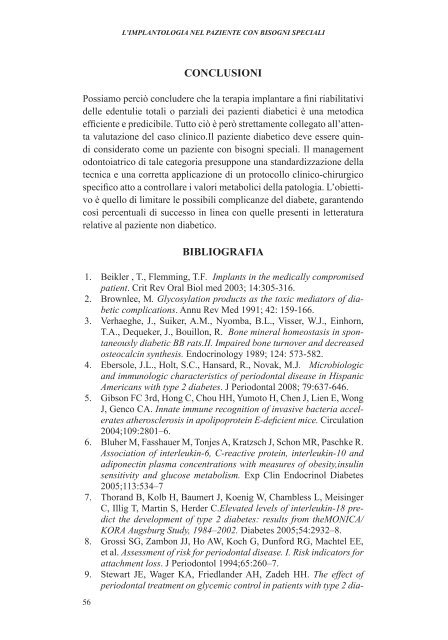l'implantologia nel paziente con bisogni speciali - Università degli ...
l'implantologia nel paziente con bisogni speciali - Università degli ...
l'implantologia nel paziente con bisogni speciali - Università degli ...
Create successful ePaper yourself
Turn your PDF publications into a flip-book with our unique Google optimized e-Paper software.
56<br />
L’IMPLANTOLOGIA NEL PAZIENTE CON BISOGNI SPECIALI<br />
CONCLUSIONI<br />
Possiamo perciò <strong>con</strong>cludere che la terapia implantare a fini riabilitativi<br />
delle edentulie totali o parziali dei pazienti diabetici è una metodica<br />
efficiente e predicibile. Tutto ciò è però strettamente collegato all’attenta<br />
valutazione del caso clinico.Il <strong>paziente</strong> diabetico deve essere quindi<br />
<strong>con</strong>siderato come un <strong>paziente</strong> <strong>con</strong> <strong>bisogni</strong> <strong>speciali</strong>. Il management<br />
odontoiatrico di tale categoria presuppone una standardizzazione della<br />
tecnica e una corretta applicazione di un protocollo clinico-chirurgico<br />
specifico atto a <strong>con</strong>trollare i valori metabolici della patologia. L’obiettivo<br />
è quello di limitare le possibili complicanze del diabete, garantendo<br />
così percentuali di successo in linea <strong>con</strong> quelle presenti in letteratura<br />
relative al <strong>paziente</strong> non diabetico.<br />
BIBLIOGRAFIA<br />
1. Beikler , T., Flemming, T.F. Implants in the medically compromised<br />
patient. Crit Rev Oral Biol med 2003; 14:305-316.<br />
2. Brownlee, M. Glycosylation products as the toxic mediators of diabetic<br />
complications. Annu Rev Med 1991; 42: 159-166.<br />
3. Verhaeghe, J., Suiker, A.M., Nyomba, B.L., Visser, W.J., Einhorn,<br />
T.A., Dequeker, J., Bouillon, R. Bone mineral homeostasis in spontaneously<br />
diabetic BB rats.II. Impaired bone turnover and decreased<br />
osteocalcin synthesis. Endocrinology 1989; 124: 573-582.<br />
4. Ebersole, J.L., Holt, S.C., Hansard, R., Novak, M.J. Microbiologic<br />
and immunologic characteristics of periodontal disease in Hispanic<br />
Americans with type 2 diabetes. J Periodontal 2008; 79:637-646.<br />
5. Gibson FC 3rd, Hong C, Chou HH, Yumoto H, Chen J, Lien E, Wong<br />
J, Genco CA. Innate immune recognition of invasive bacteria accelerates<br />
atherosclerosis in apolipoprotein E-deficient mice. Circulation<br />
2004;109:2801–6.<br />
6. Bluher M, Fasshauer M, Tonjes A, Kratzsch J, Schon MR, Paschke R.<br />
Association of interleukin-6, C-reactive protein, interleukin-10 and<br />
adiponectin plasma <strong>con</strong>centrations with measures of obesity,insulin<br />
sensitivity and glucose metabolism. Exp Clin Endocrinol Diabetes<br />
2005;113:534–7<br />
7. Thorand B, Kolb H, Baumert J, Koenig W, Chambless L, Meisinger<br />
C, Illig T, Martin S, Herder C.Elevated levels of interleukin-18 predict<br />
the development of type 2 diabetes: results from theMONICA/<br />
KORA Augsburg Study, 1984–2002. Diabetes 2005;54:2932–8.<br />
8. Grossi SG, Zambon JJ, Ho AW, Koch G, Dunford RG, Machtel EE,<br />
et al. Assessment of risk for periodontal disease. I. Risk indicators for<br />
attachment loss. J Periodontol 1994;65:260–7.<br />
9. Stewart JE, Wager KA, Friedlander AH, Zadeh HH. The effect of<br />
periodontal treatment on glycemic <strong>con</strong>trol in patients with type 2 dia-

















